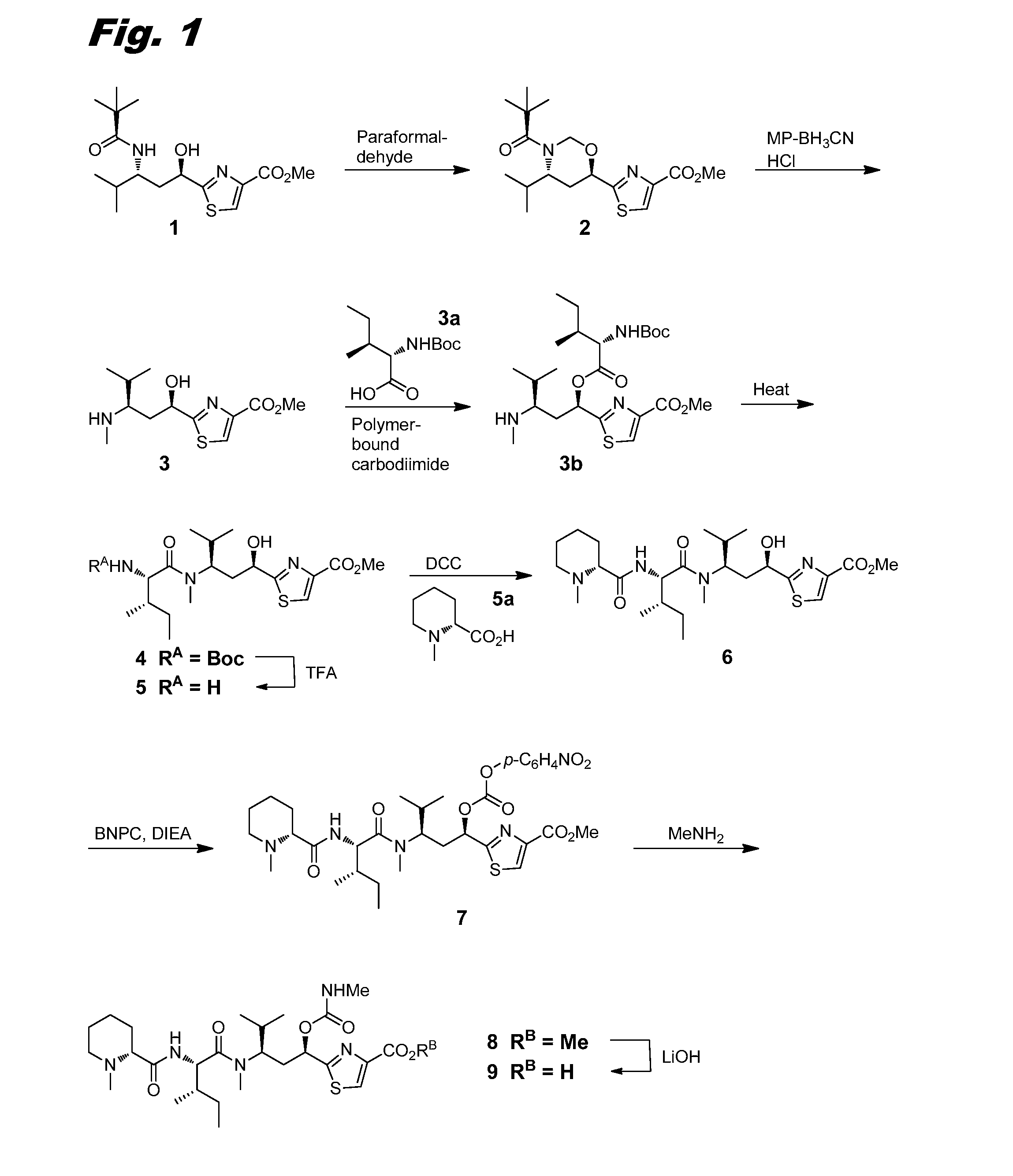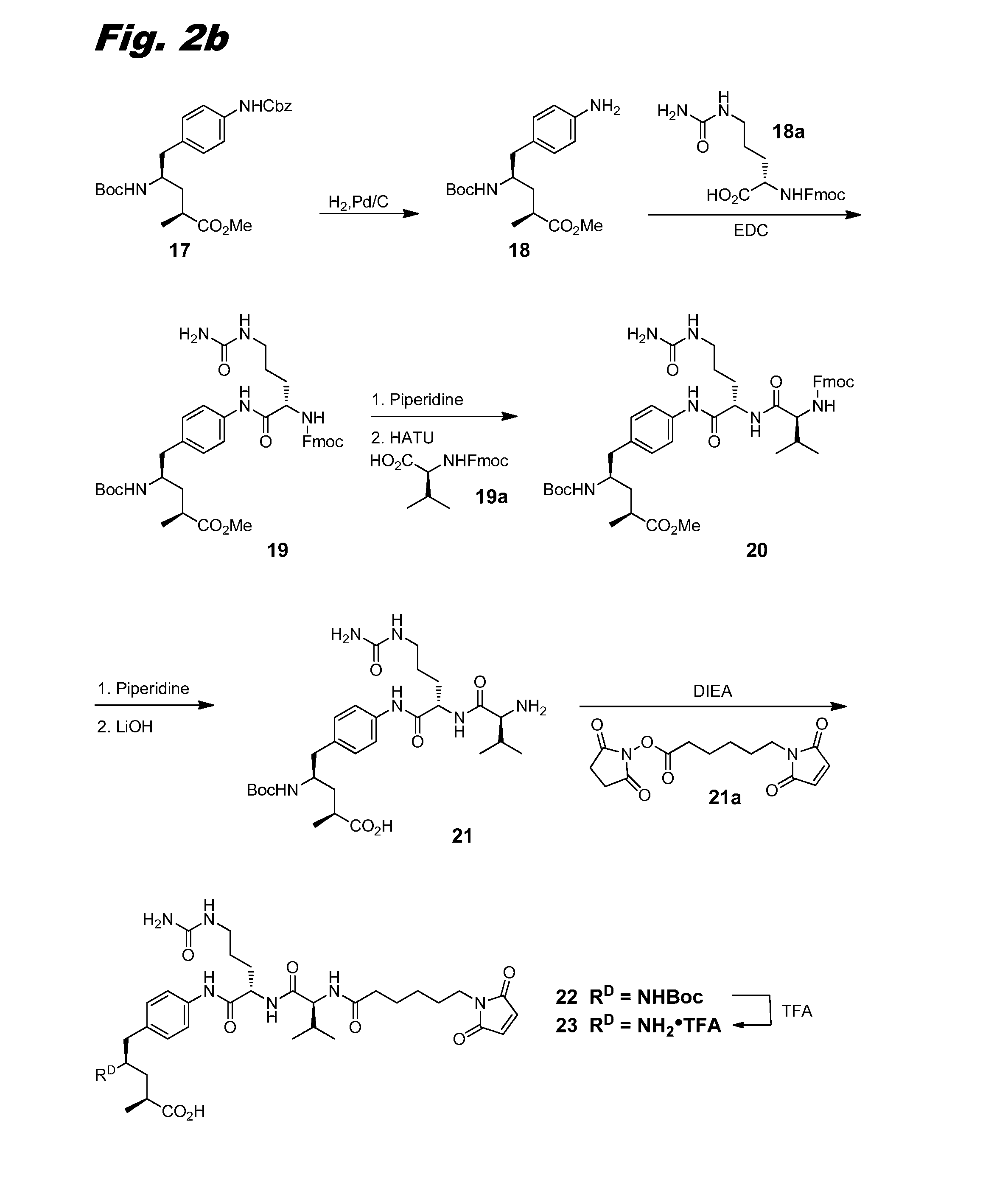Tubulysin compounds, methods of making and use
a technology of tubulysin and compound, applied in the field of tubulysin compound, methods of making and using, can solve problems such as loss of activity
- Summary
- Abstract
- Description
- Claims
- Application Information
AI Technical Summary
Benefits of technology
Problems solved by technology
Method used
Image
Examples
example 1
Compound (III-1)
[0150]This example describes the synthesis of compound (III-1), the corresponding scheme being shown in combined FIGS. 1, 2a-2b, and 3.
[0151]Compound 2.
[0152]A mixture of compound 1 (6 g, 16.6 mmol; prepared according to Peltier et al. 2006) and paraformaldehyde (9.94 g, 331 mmol) in toluene (150 mL) was heated in a sealed vessel at 70° C. for 24 h. Thin layer chromatography (TLC) showed that the reaction was complete. The reaction mixture was filtered through CELITE™ filter media and the filter cake was washed thoroughly with toluene. After evaporation of the solvent, the crude product was purified by flash chromatography eluting from silica gel with a gradient of 0-70% ethyl acetate (EtOAc) in dichloromethane (DCM) to afford 4.76 g of compound 2 as a light yellow oil. MS: (+) m / z 375.2 (M+1).
[0153]Compound 3.
[0154]Hydrochloric acid (4.0 M in 1,4-dioxane, 12.24 mL, 50.8 mmol) was added drop-wise to a solution of compound 2 (4.76 g, 12.7 mmol) in acetonitrile (62 mL)...
example 2
Compound (III-2)
[0206]This example describes a synthesis of compound (III-2), the corresponding scheme being shown in FIG. 4.
[0207]Compound 24.
[0208]N-Ethyl-N-isopropylpropan-2-amine (0.556 mL, 3.19 mmol) was added to a solution of glycine tert-butyl ester hydrochloride 23a (0.209 g, 1.596 mmol),
[0209]Fmoc-aminoxyacetic acid 23b (0.5 g, 1.596 mmol) and HATU (0.607 g, 1.596 mmol) in DMF (5 mL) at RT. After the reaction mixture was stirred at RT for 1 h, 0.1% aq. TFA (20 mL) was added. The aqueous solution was extracted with EtOAc, and the combined organic layers were dried, filtered, and concentrated. The crude product was purified by flash chromatography eluting from silica gel with a gradient of 0-70% EtOAc in hexanes to afford 0.45 g of compound 24 as a colorless oil. MS: (+) m / z 449.2 (M+23).
[0210]Compound 25.
[0211]TFA (3 mL, 1.437 mmol) was added to a solution of compound 24 (0.45 g, 1.055 mmol) in DCM (0.5 mL) at RT. The reaction mixture was stirred at RT overnight. The solvent...
example 3
Compounds (I-2) and (I-3)
[0222]The synthesis of compounds (I-2) and (I-3) is shown schematically in FIG. 5.
[0223]Compound (I-3).
[0224]DIEA was added to a solution of compound 9 (10 mg, 0.018 mmol) and HATU (6.87 mg, 0.018 mmol) in DMF (0.3 mL), adjusting the pH to 8-9. After the reaction mixture was stirred at RT for 10 min, compound 29 (prepared according to Cheng et al. 2011, Example 17; 4.56 mg, 0.018 mmol) in DMF (0.5 mL) and DIEA were added, adjusting pH to 8-9. After the reaction mixture was stirred at RT for 20 min, the reaction was quenched by addition of 4 mL of 1:1 mixture of acetonitrile and 0.1% aq. TFA. Preparative HPLC purification afforded 12 mg of compound (I-3) (I-2) as a white solid. MS: (+) m / z 788.4 (M+1).
[0225]Compound (I-2).
[0226]A mixture of compound (I-3) (12 mg, 0.015 mmol) and Pd / C, 10 wt % (4 mg, 0.015 mmol) in methanol (0.5 mL) was stirred under an H2 atmosphere overnight. The catalyst was filtered off, and the filtrate concentrated. Preparative HPLC puri...
PUM
| Property | Measurement | Unit |
|---|---|---|
| Structure | aaaaa | aaaaa |
Abstract
Description
Claims
Application Information
 Login to View More
Login to View More - R&D
- Intellectual Property
- Life Sciences
- Materials
- Tech Scout
- Unparalleled Data Quality
- Higher Quality Content
- 60% Fewer Hallucinations
Browse by: Latest US Patents, China's latest patents, Technical Efficacy Thesaurus, Application Domain, Technology Topic, Popular Technical Reports.
© 2025 PatSnap. All rights reserved.Legal|Privacy policy|Modern Slavery Act Transparency Statement|Sitemap|About US| Contact US: help@patsnap.com



